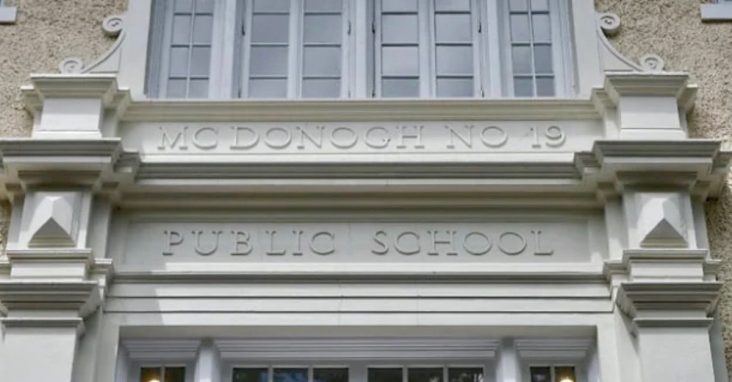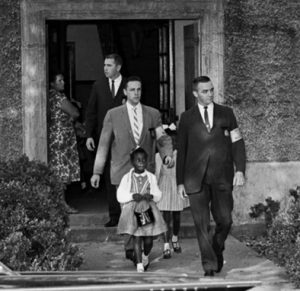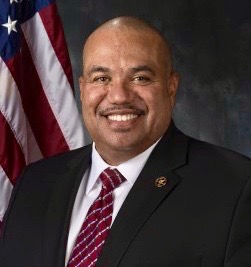Three of New Orleans Four, U.S. marshal remember 1960 integration
by March 6, 2024 1:46 pm 519 views

Three women who integrated a New Orleans public school as six-year-olds in 1960 while being escorted by U.S. Marshals, including one from Little Rock, formed a lifelong bond in that first year of school, even as they were the only children left in their class.
Gail Etienne, Leona Tate and Tessie Prevost spoke as part of a panel discussion at the Robinson Center in Little Rock March 5. The event, “The New Orleans Four and the Civil Rights Movement,” was hosted by the U.S. Marshals Museum, which is based in Fort Smith.
The three were part of the “New Orleans Four” who integrated two previously all-white public elementary schools. They were the first black children to attend the McDonogh 19 Elementary School. A fourth student, Ruby Bridges, attended a different school and did not appear at the Little Rock event.
Also speaking at the event was Herschel Garner, a native Arkansan and the last remaining deputy marshal who escorted the girls, and Dorothy Prevost, the last remaining parent. U.S. Marshals Service Historian David Turk moderated the discussion. Elizabeth Eckford, a member of the Little Rock Nine who integrated Little Rock Central High School in 1957, was in attendance.
Turk said marshals were preparing to help with the integration of Little Rock schools when Gov. Orval Faubus closed them down in 1958, ending the operation. It was the first of many school integration operations for the service. New Orleans was the first completed mission.
“The foundation of the plans the marshals used for desegregation in New Orleans and other parts of the South originated in the U.S. Marshals office in Little Rock, as they made plans for the school year following the desegregation of Central High School. It just seemed a natural fit to host the program there,” said Leslie Higgins, U.S. Marshals Museum chief programs officer. in a press release.

Asked about their memories of their first school day on Nov. 14, 1960, Tessie Prevost said her parents had received a telegram saying they would be going to McDonogh. She wasn’t told what to expect and doesn’t think her parents knew, either. Her grandmother had prayed with her every day, and she did again that day. But this time, she prayed differently – for the teachers, the students and the city.
Etienne said her memories of that day begin with riding in the car, turning the corner in front of the school, and seeing a crowd of noisy, angry people. One was pregnant. She wondered what a six-year-old could have done to make them so angry. She was afraid and didn’t know what was going on or what to expect.
Tate recalled her house being full of family and friends the first day of school. When the marshal’s car pulled up, the house grew quiet. Her mother told her to sit with her back to the seat and not to put her face to the window. Tate said she didn’t pick up on the fact that people were angry or that everyone was white, but she was able to enter the school peacefully.
One by one, the white parents came and picked up their students from the school. By the end of the first day, the three were the only students left, and that’s how it remained the rest of the year. Crowds would come and go. The windows were covered with brown paper bags so they couldn’t see out and those outside couldn’t see in.
“It was pleasant. There were no problems except leaving out and seeing this crowd and coming in the morning,” Prevost said.

Etienne and Tate said they couldn’t go outside and play, or go to the cafeteria or use the water fountain, which had been turned off. They could not go to the bathroom by themselves. But overall it was a good year. The teacher was motherly. The girls played hopscotch in the hallway and played in the stairwell. They formed a lifelong bond. In second grade, some black students came to school but only two white students returned.
Garner said he spent 30 years in the marshals service in Little Rock from 1960 until 1990, the last 20 as chief deputy. He had only been on the job about four months when he was told to report to New Orleans. The marshal’s office there didn’t have enough deputies to do its normal duties and escort the students to schools, so eight out-of-town deputies were brought in to help. Local deputies provided transportation to pick up the girls and take them to school, while he rode in the car. The New Orleans police surrounded the school and kept the crowds back.
He was there four weeks and stayed in the classrooms. After the first four days, not much was happening and it was a boring assignment.
Ronald Davis, director of the U.S. Marshals Service, said the pioneers’ courage allowed him to stand in front of the audience as the director and as an African American. He noted that the marshals service, established in 1789, is the United States’ oldest law enforcement agency. At one time it was used to hunt down fugitive slaves. He stressed the importance of remembering history, saying, “Although truth may hurt, selective ignorance is fatal.”
Ben Johnson, president and CEO of the U.S. Marshals Museum, also spoke.
